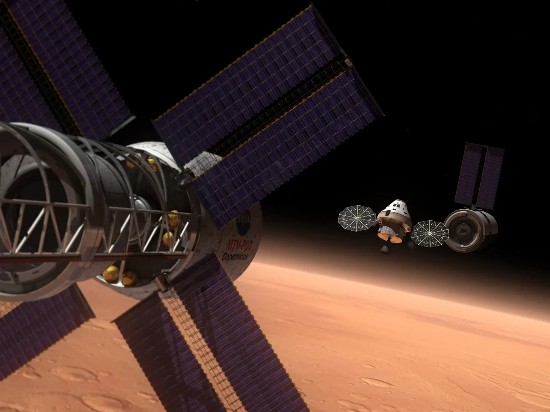From the beginning when the first rockets reached Earth orbit, space pioneers have been trying to shed our dependence on chemical-powered propulsion. The nuclear-powered options of today’s robotic spacecraft, landers and rovers use decaying plutonium to generate heat and electricity to keep them operational in the harsh realm of space and places like the Moon and Mars. And now as the United States, China, and others are once more infected by the outward urge to leave planet Earth, a different type of nuclear power is being developed. Nuclear fuel and engines are at the forefront of research and here are some of the latest stories.
A Welsh University is Developing 3D-Printed Nuclear Fuel
Bangor University in Wales is home to the Nuclear Futures Institute (NFI) where eight projects funded by the United Kingdom’s Space Agency are focused on future human space activity. Among the projects is research into the development of nuclear fuels for Deep Space missions and micro-reactors to power lunar and Martian habitats.
States Simon Middleburgh, a professor who is Co-director of the NFI, “On the moon and on planetary bodies that have day and night, we can no longer rely on the Sun for energy and therefore must design systems such as the small micro-reactor to sustain life.” He goes on to state, “Nuclear power is the only way we currently have to provide the power for that length of space travel” referring to travel to Mars. “The fuel must be extremely robust and survive the forces of launch and then be dependable for many years.”
The research the university is doing is in the development and manufacturing of several fuel configurations using additive manufacturing (3D printing) combining metallic and ceramic materials with zirconium-containing nuclear fuels.
The fuels that Bangor University develops may be what powers the first lunar and Martian colonies and the rockets to get us faster to and from the latter.

NASA Plans Nuclear Thermal and Microreactor Powerplants
It is no secret that NASA is working with the U.S. Defense Research Projects Agency (DARPA) on nuclear thermal-powered (NTP) rockets which it hopes to deploy as early as 2027. The U.S. agency is also financially seeding research jointly with the U.S. Department of Energy (DOE) to develop nuclear fission power plants to operate on the Moon and Mars.
ESA Wants to Develop Nuclear Electric
NASA isn’t the only player in this space. The European Space Agency (ESA) has several projects on the go to develop nuclear propulsion for Deep Space. One focused on nuclear electric propulsion (NEP) goes by the acronym RocketRoll and is headed up by scientists in Czechia and Germany. The project name is short for pReliminary eurOpean reCKon on nuclEar elecTric pROpuLsion for space appLications. The goal is to develop and deploy a nuclear electric-powered space tug by 2035 to provide logistical and transportation support for humans on Mars and missions beyond it.
China, Russia and Others Are in the Nuclear Mix
China is reportedly developing nuclear energy packages for future missions to the Moon and Mars. It is hard to separate fact from fiction in Chinese announcements on the subject, but purportedly, China plans to build much larger nuclear power plants for use in space with ambitions to begin missions to the Outer Planets in coming decades.
Russia appears to be working on a NEP space tug but its program is seriously underfunded and likely well behind schedule.
India’s space agency ISRO is also in the running to build a nuclear-powered engine for Deep Space missions. The Indian program is moving rapidly and could overtake Russia in the next decade in getting nuclear-based technology beyond the drawing board.
Blue Origin, the rocket company that Jeff Bezos started, is working on plans to develop a nuclear-powered rocket propulsion system. But SpaceX has not yet indicated an interest.
The U.K. is playing with the idea considering the work Bangor University is doing. Japan’s JAXA, however, appears to be reluctant to consider a nuclear option for its space program.
NTP and NEP – How They Differ
The nuclear propulsion options come in two flavours on the drawing boards so far: NTP and NEP.
How does NTP work? It uses thermal energy produced by a small fission reactor to heat liquid propellant which then generates thrust. Compared to chemical rockets like the Space Launch System (SLS) and SpaceX’s Starship, an NTP rocket would generate thrust as much as 70% greater. That means getting started on a journey to Mars would be that much faster cutting out a lot of time during transit.
How does NEP work? This technology uses far less energy than NTP and less thrust to begin with but can operate continuously over a long period to surpass even NTP speeds. In an NEP rocket, thermal energy from a small nuclear fission reactor is used to produce electricity which then ionizes a gas propellant producing thrust. The initial thrust is small but continuous so that the spacecraft accelerates for extended periods unlike high-thrust short-duration NTP or current chemical rockets. The amount of propellant needed for NEP rocket is a fraction of what has to be carried onboard by an NTP or chemical rocket.
Likely, a combination of both nuclear rocket technologies will end up being used in future missions to take advantage of the initial speeds NTP rocket engines can produce while using NEP rockets to achieve long-term acceleration for Deep Space missions.









